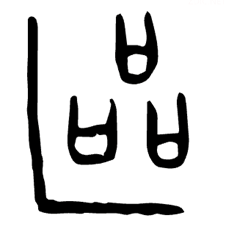The traditional character 區 (simplified 区) brings together two evocative ideas: an enclosure and many things within. Read visually, it suggests a semi‑bounded container filled with diverse “items” or lives. This pictographic resonance captures something central to regional thinking: a protected interior with dense internal relations, whose edge is present but negotiable (See in the image, the outer edge of the character is not closed). In modern usage, 区域 ranges widely, from “area” or “district” to “region” and administrative zones, mirroring the way boundaries are defined by purpose rather than fixed essence.

Today, quyu most often appears in state and policy narratives of integrated regional development. The aim is to organise flows, including people, capital, knowledge, and logistics, so that nearby provinces and metropolitan areas complement each other and realise agglomeration and coordination (Li et al., 2022). The Guangdong–Hong Kong–Macao Greater Bay Area brings together a dense constellation of city-regions around the Pearl River estuary through joint infrastructure, innovation platforms, and market-access arrangements (Xinhua Agency, 2019). The Yangtze River Delta integration blueprint links Shanghai with Jiangsu, Zhejiang, and Anhui to harmonise transport corridors, industrial specialisation, and public services across administrative borders (Xinhua Agency, 2019). In both cases, the “region” is functionally assembled around major city‑regions and corridors, where administrative borders matter but are meant to be bridged by joint plans, transport interchanges, and financial/land-use coordination.
Projected outward, Quyu often scales up to international frameworks. China–ASEAN cooperation, for instance, now includes supply-chain connectivity alongside experiments in local-currency settlement and cross-border payment linkages (Xinhua Agency, 2024). Hereby, a region is less a contiguous labour market than an intergovernmental circuitry of rules, finance, and infrastructure that knits multiple jurisdictions into a development space. The language of “regional cooperation” travels easily from domestic integration zones to these outward-facing arrangements because the operative meaning of region is functional and instrumental: a platform for coordination.
Working in Sweden reveals a different, everyday meaning of regions. The European Union anchors policy in standardised statistical tiers (e.g. NUTS 1/2/3) used for allocating and comparing Cohesion Policy funds (Becker, S. O., et al, 2010). Alongside these tiers sits a large family of legally framed cooperation programmes, most visibly Interreg, which finances cross-border projects in innovation, mobility, environment, and labour-market matching. The Öresund area, which links Copenhagen in Denmark and Malmö in Sweden, offers a concrete touchstone. The Öresund Bridge made the region lived and commutable; political cooperation under the “Greater Copenhagen” umbrella and the Interreg Öresund–Kattegat–Skagerrak programme then institutionalised collaboration to smooth frictions around transport, research linkages, and administrative differences (Danielewicz, J., 2020). In this setting, the default reference points are stable statistical tiers and formalised, rule-bound cooperation regimes rather than large national “integration regions” organised around one or two megacities.
These Chinese and European words share a value of connectivity but diverge on how regions are drawn, which scales lead, and who governs. In the Chinese usage, quyu tends to be purpose-built: boundaries are delineated to achieve integration goals, often scaling up from leading metropolitan cores to surrounding provincial clusters. Governance is steered through state-issued outlines, demonstration zones, and coordinating bodies that translate strategy into infrastructure and land-use decisions. In the European case, regionhood is more often stabilised in advance through statistical tiers and then overlaid with cooperation instruments backed by regulations and earmarked funds. Multi-level governance is formally regulated as Brussels sets frameworks and allocates resources, then member states and regions implement, and cross-border committees coordinate specific programmes.
All of this returns us to language. Quyu is not a one-to-one translation of “region.” It carries the container-plus-contents imagery of the character, the developmentalist inflection of recent Chinese policy, and the scalar plasticity to denote metropolitan areas, provincial clusters, and multi-country arrangements. European practice naturalises different anchors, including statistical tiers, functional labour markets, and legally formalised cross-border committees. Rather than looking for an exact lexical match, it may be more realistic to treat regions as problems to be solved: we draw boundaries to coordinate action, allocate resources, and make comparisons. From that vantage point, quyu reads as a verb as much as a noun, which is a continual process of regionalising spaces through policies, infrastructures, and narratives.
Connect with the Author

Riley Wenjia Ding is a PhD candidate in Innovation at Lund University, Sweden. Her research explores how innovation ecosystems in peripheral regions emerge and evolve, focusing on how universities, industries, public actors and civil society co‑shape and are shaped by the regions they anchor. She earned her Bachelor’s and Master’s degrees in Shanghai, specialising in entrepreneurship and higher education institutions in regional development.